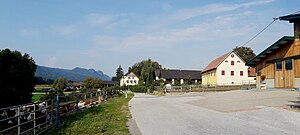Truttendorf
|
Truttendorf ( village ) locality cadastral community Truttendorf |
||
|---|---|---|
|
|
||
| Basic data | ||
| Pole. District , state | Klagenfurt-Land (KL), Carinthia | |
| Judicial district | Klagenfurt | |
| Pole. local community | Grafenstein | |
| Coordinates | 46 ° 36 '47 " N , 14 ° 26' 37" E | |
| height | 421 m above sea level A. | |
| Residents of the village | 99 (January 1, 2020) | |
| Building status | 32 (2001) | |
| Area d. KG | 5.93 km² | |
| Statistical identification | ||
| Locality code | 00718 | |
| Cadastral parish number | 72190 | |
| Counting district / district | Grafenstein area (20409 001) | |
 Truttendorf is characterized by agriculture |
||
| Source: STAT : index of places ; BEV : GEONAM ; KAGIS | ||
Truttendorf is a village in the Grafenstein municipality in Carinthia . It is located about two kilometers west of Grafenstein on a hill above the Gurk and has 93 inhabitants (2001 census).
The village owes its name to a ford through the formerly wild river, which was already known in the early Middle Ages. According to legend, the treading spirits walked around such fords - the southern Carinthian vernacular knows them as turkeys or druds, they dragged hikers passing down into the whirlpool.
history
Already in the late Roman period, ie during the years of the great migrations have located, must Truttdendorf a Germanic farm. The courtyard was the natural, administrative, and judicial center of a larger settlement. Since such a farm had to cover at least 30 hectares, it was always the seat of the leading classes of a region or country. Excavation remains from those days have been preserved.
Truttendorf was mentioned in a document as early as 963, when Archbishop Friedrich I of Salzburg made a basic exchange with a Carinthian nobleman, Mrs. Mathild von Gurnitz. Truttendorf came to Frau Mathild. Until the High Middle Ages the village belonged to the noble von Truttendorf family; their coat of arms shows the Drudenfuß , or the pentagram . The Truttendorfer were ministerials of the Counts of Görz until the 14th century . With Ostermann Truttendorfer, mentioned in a document from 1442, the family went out.
As early as the 12th century, a defense tower was built in Truttendorf to secure the settlement area against the Turks invading Lower Carinthia via the Loibl Pass . Until 1349 it belonged to the nobles von Truttendorf. They were succeeded by Jakob Zwytar as the bearer of this princely fief . The von Zwytar family was in the service of the Benedictine monastery of St. Paul in Lavanttal . The sex died out with Margarethe Zwytar (or according to other documents, Zwitter), whose husband, Hans Mordax, was enfeoffed with Truttendorf in 1468. He appointed noble Niklas Wildenstainer as his deputy. He was responsible for defending the surrounding land and the homesteads against the Turks invading again. In fact, in 1476, the Wildenstain was able to successfully defend the tower against the siege by the Turks. In 1481 Hans Mordax sold the fortified tower and the land belonging to it to Niklas Wildenstainer. In the same year, the noble Christoph Höritsch acquired the still ravaged property. In that year Truttendorf became an imperial fiefdom.
In 1580 the Höritsch sold the tower to Christoph Haim zu Truttendorf and Sorgendorf. The Haim family had the defense tower torn down and built Truttendorf Castle. A depiction of Valvasor shows a sprawling, two-storey building with two massive front towers, surrounded by stables and servants' buildings, behind high and crenellated walls.
The Haim family died out at the beginning of the 17th century with the member of the state parliament, Andrä Haim zu Truttendorf and Sorgendorf. On April 25, 1613 he sold the castle to the noble Hans Kochler. As early as 1621, the palace and the noble residence in Truttendorf passed to the noble Johannes Khemetter zu Trybein.
The Khemetter family sat at Truttendorf Castle until 1710. Then the family went out with Johann Freiherr von Khemetter zu Triebein on Truttendorf. His three daughters were now enfeoffed one after the other with the castle. After the death of Franziska and Isabella Khemetter, the noble seat came to Ultima Khemetter in 1739, who was married to the lord of the castle Anton Mettnitz zu Saager. The Lordship of Truttendorf remained in the possession of Messrs. Mettnitz zu Saager until it was sold to Andrä Graf Orsini-Rosenberg on December 1, 1777, who dissolved the estate and incorporated it into his own possessions in Grafenstein.
Nevertheless, the castle, which no longer belonged to the fiefdom, was sold to the Prince von und zu Liechtenstein at the beginning of the 19th century . He was followed by Miller von Eichholz, then Stefan Mauthner and after him the Stromberger family who still own Truttendorf today. The castle was largely demolished after a fire around 1850.
literature
- FX Kohla, GA v. Metnitz, Gotbert Moro: Carinthian Castle Studies, Vol. 1 . Habelt, R, Klagenfurt 1973, ISBN 3-7749-0433-2 .
- FX Kohla, GA v. Metnitz, Gotbert Moro: Carinthian Castle Studies, Vol. 2 . Klagenfurt.
- Archives for Patriotic History and Topography Vol. 52, oaO
- Eberhard Kranzmayer: Place name book for Carinthia . Vol. I and II oaO
- Peter Orasch: market town of Grafenstein. Festschrift on the occasion of the market survey . Klagenfurt 1990.


